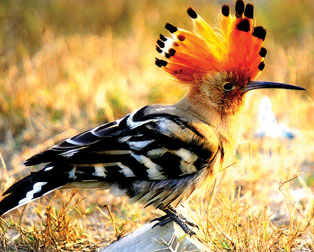Stranger in the garden
by K.G.H. Munidasa
One afternoon last week, a strange bird flew into the garden from the
nearby scrub, after a shower of rain. From the description given by my
wife, I could only surmise that it was a Hoopoe. My grandson who had
watched the feathered visitor closely later said it was coloured exactly
like his pet Starred Tortoise. Perhaps, he noted the black and white
zebra-markings, on the bird's body and wings.
The Ceylon Hoopoe Upupa epops ceylonensis Reichenbach, Sin. "Poruwa-Kurulla"
is the only member of the family of UPUPIDAE, represented in Sri Lanka.
Widely but locally distributed, in small numbers, throughout the
Low-Country Dry Zone and in the drier Uva Hills to altitudes of 6,000
feet, it occasionally visits drier areas of the Wet Zone.
 |
|
The Ceylon Hoopoe. |
Larger than the Common Mynah, the hoopoe cannot be mistaken for any
other species found in the island, in form and colouration. It is
dressed in fawn colour plumage with zebra-stripping on its back, wings
and tail.
The broad fan-shaped crest, freely raised and lowered, makes the
identity of the hoopoe beyond doubt at the first glance. While hunting
the crest is depressed and sticks out behind the head, suggesting, in
opposition to the long beak a pick-axe. Whenever the bird is in a state
of alert or on alighting from flight, the crest is erected in the form
of a cock's comb or as a British writer puts it as a "silken Japanese
hand fan".
The flight of the hoopoe is described as wavering and its call note a
soft hawpawp ....hawpawpawp (Henry), repeated monotonously or hoopo,
hoo-po-po (Salim Ali), and its popular name is obviously an onomatopoeic
rendering of the call.
Nesting
My first sight record of the Ceylon Hoopoe was in a lately harvested
sugarcane field at Muwangala, close to the Hingurana sugar factory in
Gal Oya, in 1964. Subsequently, a couple of months later, I came across
a nest of the species, hardly 500 metres from the former place. It was
in a giant Satin tree at the edge of scrub jungle.
Placed at the junction of two large branches, about 10 feet up, the
nest was out of view, however much I tried to get a glimpse of it with
my binoculars, from different angles of view. One of the pair was on a
branch lower down, while the other was apparently incubating the eggs.
In March 1975 in the monthly notes of the Ceylon Bird Club, I found a
reference made to the discovery of an instance of nesting of the bird in
the garden of St. Thomas' College, Gurutalawa, where definite
observations had been made on nests in June and October of 1963 as
quoted below.
"The nest holes were deep, about eight feet from the ground level in
Albizzia trees, and in both cases contained a single white egg. I
remember that both holes had a strong, unpleasant smell. In one instance
a hoopoe chased off a Common Mynah that got too close to the nesting
hole, then returned to the hole and covered it with both wings
outspread. No sound was uttered by the bird during the episode".
Again in that year, according to first hand observations submitted to
the CBC by an Assistant Director of the Department of Wildlife
Conservation, he had come across the Hoopoes breeding in Yala National
Park.
The nest was in a cavity of a dead Andara tree, four feet above the
ground and contained two young. In February 1969 the same observer had
found a nest in a Margosa tree in the Mannar town, which contained two
young.
The Hoopoe avoids areas of thick forest and is found very commonly in
open country, usually in the neighbourhood of scrub, and the outskirts
of village lawns.
It feeds almost entirely on the ground, being partial to
groundfeeding insects and their larvae, which form the major portion of
its diet it walks and runs with great ease, diligently probing the soil
under the roots of grass or turning up the dead leaves in a constant
search for insect-pray. When disturbed it would fly up into a tree or a
nearby building, but as a rule does not feed anywhere else, except on
the ground.
Nesting behaviour
It is in its nesting arrangements that the hoopoe is most interesting
for observation and study. In Sri Lanka it has been found to breed
during the rainy season in the cavity of a tree, earth bank or building,
the chief requisite being the gloomy situation. The nest has been
described as poor affair being merely a collection of rubbish placed
roughly on the bottom of the cavity selected.
The female alone incubates the eggs, sitting very tight, being fed
therein by the male, as the hornbills are known to do, and developing a
very unsavoury odour, apparently as the result of a secretion from her
oil-glands, during the incubation period.
It is believed that the hoopoes keep their nests filthy and stinking
purposely to keep any possible predator away.
The Hoopoe breeds during the North East monsoon and occasionally in
June and July, laying a clutch of 4 to 7 eggs, which are bluish or
greenish-white at first, but soon becoming stained.
|

